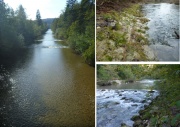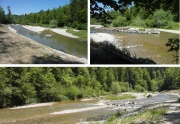Difference between revisions of "Töss"
(→Monitoring before and after implementation of the project) |
(→Töss) |
||
| (7 intermediate revisions by 2 users not shown) | |||
| Line 9: | Line 9: | ||
==Site description== | ==Site description== | ||
| − | The Töss is a 56 km long river flowing in the north east of Switzerland. The river originates in the north east of the Swiss Alps, and forms the Töss valley. As well as the Thur river (flagship restoration measure), it is a tributary of the Rhine river which originates in the Swiss Alps and ends in the North Sea. The Töss is a pre-alpine river, without natural or artificial reservoirs along its course. The morphological conditions have been highly modified along its 56 km course. It contains numerous artificial weirs and embankments, constructed in the early 20th to protect cities against floods and provide more land for agriculture. Only the lower part of the river section, close to the connection with the Rhine River, is in good conditions, with almost natural morphology and pristine pool/riffle structure. To date, restoration efforts are made to restore, locally, a natural morphology within the river. The aim is to increase natural habitats, without to reduce water pumping efficiency for local citizens. | + | The Töss is a 56 km long river flowing in the north east of Switzerland. The river originates in the north east of the Swiss Alps, and forms the Töss valley. As well as the Thur river (flagship restoration measure), it is a tributary of the Rhine river which originates in the Swiss Alps and ends in the North Sea. The Töss is a pre-alpine river, without natural or artificial reservoirs along its course. The morphological conditions have been highly modified along its 56 km course (figure below). It contains numerous artificial weirs and embankments, constructed in the early 20th to protect cities against floods and provide more land for agriculture. Only the lower part of the river section, close to the connection with the Rhine River, is in good conditions, with almost natural morphology and pristine pool/riffle structure. To date, restoration efforts are made to restore, locally, a natural morphology within the river. The aim is to increase natural habitats, without to reduce water pumping efficiency for local citizens. |
| + | |||
| + | [[File:Toess_Degraded.jpg|thumbnail|none|Overview of the degraded Toess section (left), bank revetment (top), and a ramp (bottom) (A. Paillex)]] | ||
==Measures selection== | ==Measures selection== | ||
| − | The Töss was restored in 1999 along a reach of 200 meters. The river was widened on both sides of the main river channel. Along the course of the river, embankments were removed to provide a large space to the river. Additional wood | + | The Töss was restored in 1999 along a reach of 200 meters. The river was widened on both sides of the main river channel. Along the course of the river, embankments were removed to provide a large space to the river (Figure 2). Additional blocks of rocks and wood were added in the middle of the river to enhance the ability of the river to recreate islands. Restoration efforts are expected to increase diversity of instream habitats and corresponding biota. |
| + | |||
| + | [[File:Toess_Restored.jpg|thumbnail|none|Overview of the degraded Toess section (bottom), restored bars (left), and islands creating side channels (right) (P. Reichert)]] | ||
| + | |||
| + | ==Hydromorphological and ecological response== | ||
| + | |||
| + | To date, hydromorphological and biological indicators both suggest an increase in river quality and conditions after restoration. All organism groups benefited from restoration to different degrees, except for the fish and for the aquatic vegetation (table below). Improvement was most pronounced for ground beetles, which benefited from recreation of gravel bars following the river widening. At a higher spatial scale, the presence of many barriers within the Töss River could explain this lack of new fish species colonizing the restored reach. However the density of fish species within the restored site increased and showed a positive effect of restoration on the species already present in the reach. | ||
| + | |||
| + | {| class="wikitable" | ||
| + | |- | ||
| + | ! Indicators !! Degraded !! Restored | ||
| + | |- | ||
| + | | Macroinvertebrates || 47 || 48 | ||
| + | |- | ||
| + | | Fish || 4 || 4 | ||
| + | |- | ||
| + | | Ground beetles || 2 || 9 | ||
| + | |- | ||
| + | | Aquatic vegetation || 4 || 1 | ||
| + | |- | ||
| + | | Riparian vegetation || 36 || 39 | ||
| + | |- | ||
| + | |} | ||
| + | |||
==Socio-economic aspects== | ==Socio-economic aspects== | ||
| − | + | Socio-economic studies will complement ecological approaches, to assess the benefits or costs of restoration efforts. A positive effect of this enhanced naturalness is an increased number of people visiting the restored site, especially on sunny days. This is supported by an easier access to the river and more opportunities for recreational activities. The Töss restoration is an interesting example of river restoration and management in Switzerland, providing information concerning restoration effects, and stimulating current and future studies. | |
==Extra background information== | ==Extra background information== | ||
| − | == | + | Link to project website: |
| + | |||
| + | http://www.awel.zh.ch/internet/baudirektion/awel/de/wasserwirtschaft/bauen_am_und_im_Wasser/neues_gewaesserschutzgesetz/umsetzungsprogramm/teilprojekt2_revitalisierung.html | ||
| + | |||
| + | ==Contact person== | ||
| − | + | Dr. Amael Paillex (E-mail: Amael.Paillex[at]eawag.ch), Eawag, Swiss Federal Institute of Aquatic Science and Technology, Überlandstrasse 133, CH 8600 Dübendorf, Switzerland | |
[[Category:Case_studies]] | [[Category:Case_studies]] | ||
Latest revision as of 15:13, 9 June 2015
Töss
Site description
The Töss is a 56 km long river flowing in the north east of Switzerland. The river originates in the north east of the Swiss Alps, and forms the Töss valley. As well as the Thur river (flagship restoration measure), it is a tributary of the Rhine river which originates in the Swiss Alps and ends in the North Sea. The Töss is a pre-alpine river, without natural or artificial reservoirs along its course. The morphological conditions have been highly modified along its 56 km course (figure below). It contains numerous artificial weirs and embankments, constructed in the early 20th to protect cities against floods and provide more land for agriculture. Only the lower part of the river section, close to the connection with the Rhine River, is in good conditions, with almost natural morphology and pristine pool/riffle structure. To date, restoration efforts are made to restore, locally, a natural morphology within the river. The aim is to increase natural habitats, without to reduce water pumping efficiency for local citizens.
Measures selection
The Töss was restored in 1999 along a reach of 200 meters. The river was widened on both sides of the main river channel. Along the course of the river, embankments were removed to provide a large space to the river (Figure 2). Additional blocks of rocks and wood were added in the middle of the river to enhance the ability of the river to recreate islands. Restoration efforts are expected to increase diversity of instream habitats and corresponding biota.
Hydromorphological and ecological response
To date, hydromorphological and biological indicators both suggest an increase in river quality and conditions after restoration. All organism groups benefited from restoration to different degrees, except for the fish and for the aquatic vegetation (table below). Improvement was most pronounced for ground beetles, which benefited from recreation of gravel bars following the river widening. At a higher spatial scale, the presence of many barriers within the Töss River could explain this lack of new fish species colonizing the restored reach. However the density of fish species within the restored site increased and showed a positive effect of restoration on the species already present in the reach.
| Indicators | Degraded | Restored |
|---|---|---|
| Macroinvertebrates | 47 | 48 |
| Fish | 4 | 4 |
| Ground beetles | 2 | 9 |
| Aquatic vegetation | 4 | 1 |
| Riparian vegetation | 36 | 39 |
Socio-economic aspects
Socio-economic studies will complement ecological approaches, to assess the benefits or costs of restoration efforts. A positive effect of this enhanced naturalness is an increased number of people visiting the restored site, especially on sunny days. This is supported by an easier access to the river and more opportunities for recreational activities. The Töss restoration is an interesting example of river restoration and management in Switzerland, providing information concerning restoration effects, and stimulating current and future studies.
Extra background information
Link to project website:
Contact person
Dr. Amael Paillex (E-mail: Amael.Paillex[at]eawag.ch), Eawag, Swiss Federal Institute of Aquatic Science and Technology, Überlandstrasse 133, CH 8600 Dübendorf, Switzerland
Related Measures
- Establish environmental flows / naturalise flow regimes
- Facilitate downstream migration
- Remove barrier
- Widen water courses
- Allow/increase lateral channel migration or river mobility
- Remeander water courses
- Initiate natural channel dynamics to promote natural regeneration
- Remove sediments
- Remove bank fixation
- Remove or modify in-channel hydraulic structures
- Lower river banks or floodplains to enlarge inundation and flooding
- Remove hard engineering structures that impede lateral connectivity
- Construct semi-natural/articificial wetlands or aquatic habitats
- Set back embankments, levees or dikes

